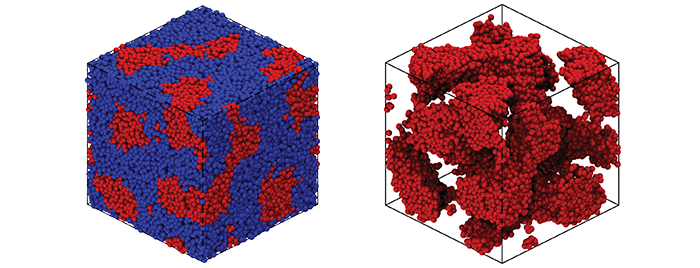To enable the rational design of future materials, such as batteries that could more safely and efficiently power electric cars, a research group at The Ohio State University is developing an innovative modeling approach to reveal the details of the microscopic structure and dynamics in microphase-separated polymer electrolytes.
“Safe batteries of high energy density and low cost are an underlying requirement to meet multiple societal needs, such as reducing carbon and pollutant emissions by switching to electric cars,” said Lisa Hall, Ph.D., the HC Slip Slider Professor of Chemical and Biomolecular Engineering at Ohio State.
“This has driven research into solvent-free, non-flammable battery electrolytes in recent years,” Hall said. “Such electrolytes are inherently safer in case of battery failure or damage. Certain microphase-separated polymer electrolytes would also save weight, because they are mechanically robust enough to be used in conjunction with a solid lithium electrode—one-tenth the weight of a typical graphitic electrode.”
However, Hall points out, ion conductivity of these polymer electrolytes is lower than that of conventional electrolytes, a feature that impedes their adoption in batteries. It remains unclear how to adjust the many material parameters to improve conductivity, in part because the mechanism of ion conduction is not well understood.
Using simple models, we can build a general picture of how salt and tapering affects microphase separation and ion conduction across the whole class of microphase separating polymers. This can yield general guidelines for how to choose future materials, in contrast to atomistic simulations, which would show a detailed picture of one or a few particular chemical systems. Additionally, the time and length scales of interest in these systems would be difficult or impossible to reach using fully atomistic simulations or other very detailed modeling. Therefore, we propose to create, test, and use what we conceive of as the simplest possible microscopic models that accurately describe microscopic morphology and ion transport in salt-doped microphase separated polymers.
In moving to a salt-doped system, we need a model with more detail than SCFT and that includes local packing effects. We have already implemented such a model in both fDFT and MD (as is a major component of the proposed work, except without salt) and compared the resulting density profiles as a function of taper length.
This work will create, optimize, and use simple models of neat and salt-doped microphase separating copolymers. In contrast to prior work, this model will both include long-ranged electrostatics and show the details of ion dynamics and conduction in such materials. Additionally, we will study for the first time how tapering the copolymer composition between the blocks changes the phase diagram and the location of ions within the microphase separated structure and the effects of this on ion conduction. Besides the interest in using tapering as an additional control variable to allow optimization of material properties, the change in the interface as a function of tapering will allow this work to develop a better scientific understanding of the effect of the interface on conduction (versus considering only pure diblock materials). Thus we expect to elucidate the major mechanism of ion transport and how it depends on the morphology. The models’ results along with comparisons with other theory and experiments will significantly broaden our knowledge of the morphology, thermodynamics, and dynamics of microphase separated polymer electrolytes and suggest new polymers to be used in improved electrolytes in the future.
###
Written by Jamie Abel, (614) 292-6495; jabel@oh-tech.org

